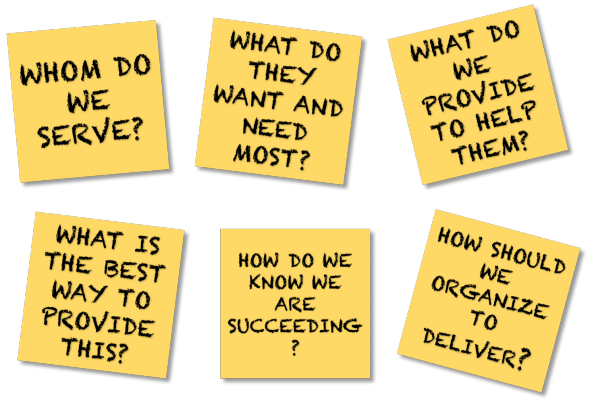
In business competition, do best company really exists? It all depends, because there is no single way to compete. The biggest mistake in strategy, is to think there is only one way to compete. There are different ways to compete, depending on what categories of customers you choose to serve, and the type of needs, you choose to meet. Strategy is all about creating unique values for the set of customers you choose to serve. It is about making choices, and the fundamental of choice is to determine who to serve. Strategy, is different from your company’s mission statement. It is your positional advantage to attain your goals.
Doing the same thing as your competitor does, is not strategy. If your competitor is employing a low-cost strategy, it becomes difficult for you to win if you chase them, by employing a low cost strategy. The essence of strategy, is to find a unique position in your business value chain that delivers unique value to the set of customers, you choose to serve. Strategy is a whole set of long term choices that you make, to distinguish yourself from competitors.
If you are trying to do the same thing as your competitors do, it’s not a strategy, but operational excellence. There are a lot of best practices that you have to do, to be a good company. You need the right kind of machines, quality control system, distribution network, good advertising etc. And if you are not employing best practices, you will lose, irrespective of your strategy. First is to implement all the best practices, you can find in your industry. And when you do, it is called operational excellence; raising the bar on the same basis of competition, with your competitors. Strategy on the other hand, is supernatant to operational excellence. It is built on best practices, but also includes a set of choices that you make, to define the uniqueness of your business. The story of Intel, comes quickly to mind here:
Register for Tekedia Mini-MBA edition 19 (Feb 9 – May 2, 2026): big discounts for early bird.
Tekedia AI in Business Masterclass opens registrations.
Join Tekedia Capital Syndicate and co-invest in great global startups.
Register for Tekedia AI Lab: From Technical Design to Deployment (begins Nov 15th).
Intel (integrated electronics) was founded in 1968, aimed to be the leader in developing semiconductor memory for mainframes and minicomputers. With the rise of personal computers in the 1980s, Intel’s business model came to focus on PC. However, there was a problem: Intel and other chip manufacturers were able to rapidly develop new chips that make each generation of chip obsolete. For instance, Intel’s 16-bit microprocessor called the 286, was replaced within three years by the 386, a 32-bit microprocessor. Despite this huge success, nobody was buying it. Everybody was still wedded to the 286 chip, whereas the 386 was a far better product. Intel, decided to make a strategic shift in marketing.
Earlier on, energy has been focused on marketing the chips to design engineers at the computer manufacturers themselves. But as the number of consumers increased and less technical I.T managers took over the decision making for PC manufacturers, design engineers, no longer have the same influence anymore. Intel’s decision was now, to reach the end users directly and explain to them that faster chips produces superior performance. This gave rise to the licensed Intel Inside logo on PC. All manufacturers had to do, was to put Intel’s logo on the bezel of the PC and in any ads. This strategic move, went a long way to really establish Intel’s image. In 1992, the first full year of Intel Inside, sales worldwide increased 63%. The company’s share of the microprocessor market has stayed near 80%. No doubt, Intel is making a solid product and likewise its competitor. What truly separated Intel, was the choice of whom to advertise to; thus changing the basis of competition.
Another key factor of a successful strategy, is that a great strategy, doesn’t please every customer. If you are trying to please every customer, then you don’t have a strategy. It is about choosing who exactly you want to please, and then engineering your value chain, to deliver on that promise. Strategy, must be functionally continuous, collective and must integrate all pieces of the value chain. It takes time to implement strategy and so, you can’t be changing strategy every time. In strategy, there must be trade-offs. For you to deliver one benefit, you have to give up another benefit. The crux of strategy is to choose what not to do. It is the service you don’t offer, the benefits you don’t offer and the promises you don’t give.
Finally, what kind of competition are you creating in your industry? Are you competing head-to head on price (Zero sum competition), or are you competing on strategy (positive sum competition). When competition is based on price alone, the profits of a company, depends on the loss of another. However, competition based on strategy, opens up new opportunities, that makes it possible to serve new customers and create new value. In recent times, strategy is evolving from just an analysis, to an innovation. Now, it is characterized by a high degree of uncertainty, unpredictability and big change. Across domains, companies are shifting from a Zero sum, to positive sum competition, to explore new opportunities. Portfolios of business models, accelerators, merger and acquisition, strategic partnerships, are moves by legacy companies to expand the perimeters of their value chain, driven by the digital revolution. In all, the essence of strategy, is making choices that delivers unique value proposition, to the category of customers you choose to serve.



Intel has got really good strategies. No wonder they are one of the top processor manufacturing company